On October 20, 2024, I took a trip to the National Museum of Natural History and visited four different exhibits to see how climate change was presented through the lens of different topics. These exhibits included “Cellphones: Unseen Connection,” “Humans Change the World,” in the Human Origins exhibit, and some other displays in the Sant Ocean Hall and the Deep Time Hall. Through each exhibit, climate change was displayed in different ways that highlighted how climate has changed in the past and how it’s changing currently, along with the impacts it has on people. And as seen from all these exhibits, I’ve learned just how complex climate change is even in the past, and one component goes into it and what consequences have occurred because of it.
I first started out in the Sant Ocean Hall over by “The Changing Ocean” portion of the hall. Here I watched two videos, one on the great pacific garbage patch and the other was called “No Sunlight No Problem,” which was on benthic organisms in deep sea ecosystems. The garbage patch video gave some simple explanations on the processes that led to the patch being formed and it also cleared up some misconceptions about it. Such as explaining ocean currents and even showing how those currents led to a collection of microplastics in the Pacific. It also cleared up that the garbage patch wasn’t your usual macroplastics like bottles, but instead a patch of microplastics that can span deep in the water and can be invisible to the eye. And it also explained just how dangerous these patches are to sea life, and that the best way to reduce the patch is prevention of plastics washing in and through beach clean up. All in all, the video explains the issue very well and takes all these complex ideas and summarizes them for a general audience. Plus there isn’t much hard data shown, with most information being shown through cartoonish pictures and videos that appeal to a younger audience.
In the second video, they went over how Benthic sea creatures live without the need for sunlight to produce the very foundation of ecosystems, being plants. Instead, these creatures live off of methane from decomposing organisms deep sea. They explain that deep sea creatures are good for the Earth in that they keep methane deep underwater, unable to escape into the atmosphere. For the most part, the video was sort of easy to understand until they started to talk about the commercial value of these deep sea ecosystems. They mentioned something about the medicinal value of some of the deep sea fish species that live in these dark areas, but never went into too much detail about it. I feel like this just caused confusion and didn’t really add too much to the video’s information since most people may not be thinking about how commercially accessible the deep sea is. Other than that, the basic ecosystem explanations given were very simple and helpful.
I also went to the Global Ocean Video portion of the exhibit, where many of Earth’s functions were explained through a projected map of the Earth.

First it went over tectonic plates, displaying their outlines, how they’ve changed the layout of the continent from Pangea to now, and how they cause things like earthquakes, eruptions, and tsunamis. Then it went over ocean currents, transporting cold water, warm water, and nutrients around the world. Finally it went over how the Earth was created, starting as a hot sphere of molten rock but soon turning into a chemical whirlpool that allowed life to form in what it is now. Overall, I feel like the format was very effective because in most contexts, this type of information would be presented on paper, in timelines, or in slides with little continuity. But the Earth projection allows museum goers to understand the full scope of Earth’s changes and ust how these systems interact with each other on a simpler scale. It’s great for kids as an especially interesting visual, and also works great for adults who want to learn more about the Earth systems.
After spending time in the Ocean Hall, I moved onto the Koch Hall of Fossils, looking at how the climate has changed in the past for land animals. Firstly, I visited two miniature dioramas that were scattered around the hall. One of these was from 24 million to 16 million years ago, where CO2 was 50% higher than today, temperatures were 5-12 deg F higher than today, and sea level was 330 ft higher than today. I felt as though at this diorama there wasn’t many visuals that could help us visualize just how significant these numbers were. Plus the display looked too similar to our current world with plants looking similar and animals being the most distinct part of the display. If there were more visuals to compare against such as showing how high sea level really was relative to current day, then maybe it would’ve been more exhibit. I also went to another one from 76 million to 66 million years ago, where CO2 was 4 times higher, temperatures were 16-17 deg F higher, and sea level was 650 to 740 ft higher. This display felt much more effective as it used the average human height to scale against some of the information provided. Plus, the replica was much more distinct where we could see the plants that existed way back when that didn't look like anything we have today. For the most part, this diorama was pretty effective in conveying information and showing just how different the climate was back then.
Then we went to one of the walls in the exhibit showing how climate has changed throughout Earth’s history and how it has impacted living creatures. They start 2.6 million years ago, showing the fossils of different animals that went extinct due to being unable to adapt to changing climates. This portion also shows how we know what past climates were like through methods like spore samples or ice coring, helping us get an idea of what past climates were like. There was also a video that showed how these methods have helped us learn that CO2 levels have risen 45% since 1860 due to humana activity, leading to melting ice, stronger storms, and bigger impacts. Then there’s a portion later on that shows how humans have changed the climate and many organisms, where an entire wall is taken up by the percentage of species that have gone extinct due to humans on each continent. I feel as if this exhibit does a good job at how historical information can help us understand our past and prepare for the future, especially with climate change due to human causes. It displays the full extent of what humans have done to the Earth’s climate, and goes into detail at how exactly we know all this information.
Next I went to the Koch Hall of Human origins to see just how humans have changed due to things like climate and migration. Out of many of the topics talked about in the hall of human origins, I focused on evolution, climate change, and tools. For evolution, there were mostly physical replicas and fossils shown on display to show changes in our bodies and minds when compared to our ancestors. Such as with the evolution of feet in humans, I saw footsteps molded into the floor of the exhibit. There were also footprints on display comparing human feet to the feet of other relatives like chimps and older ancestors.
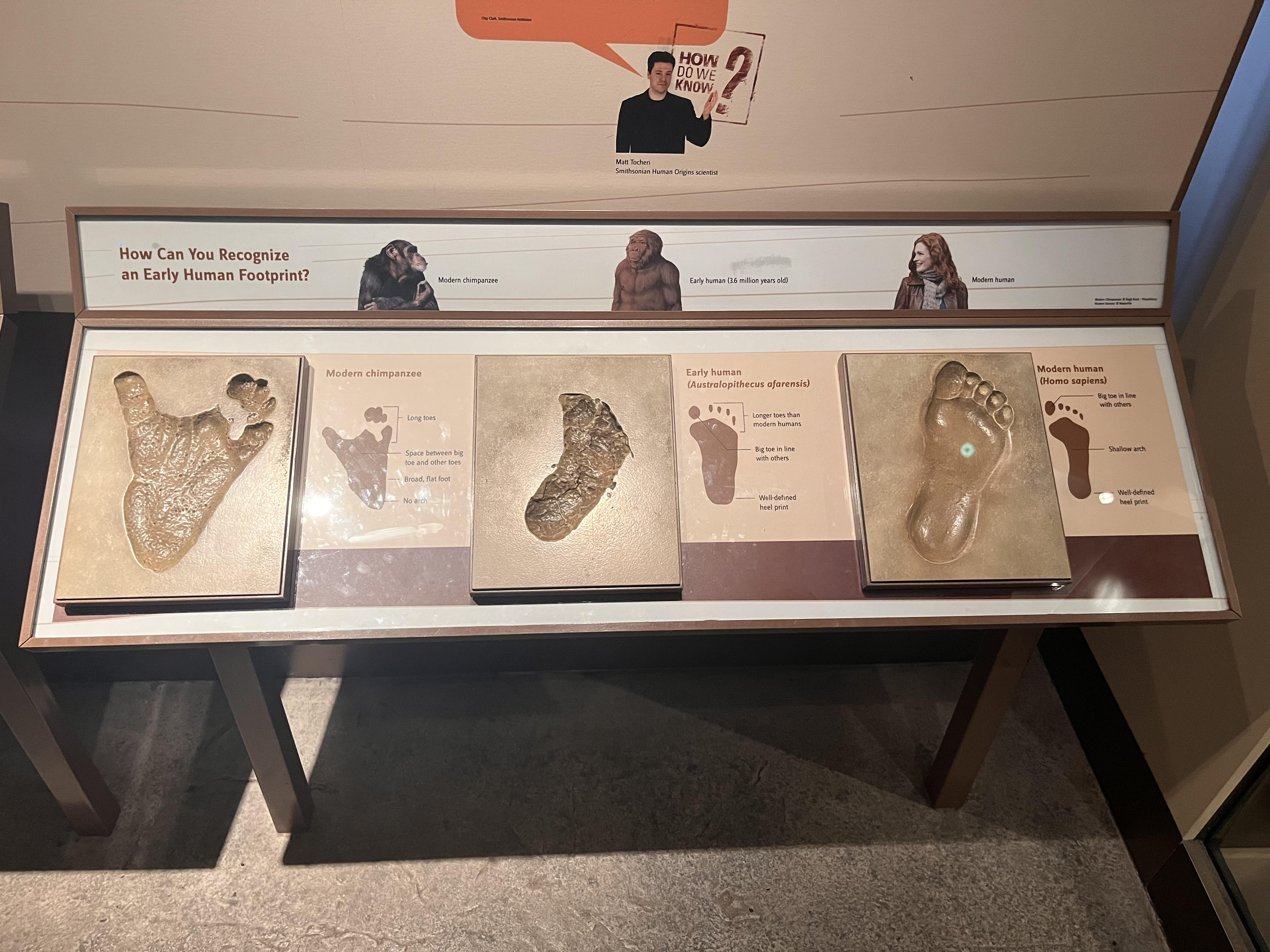
There was also a wall showing what traits changed in humans, such as bigger brains, bipedalism, longer childhoods, and more. I also saw the evolution of skulls from ancestors to humans, showing how they had to increase in size to accommodate our growing brains.
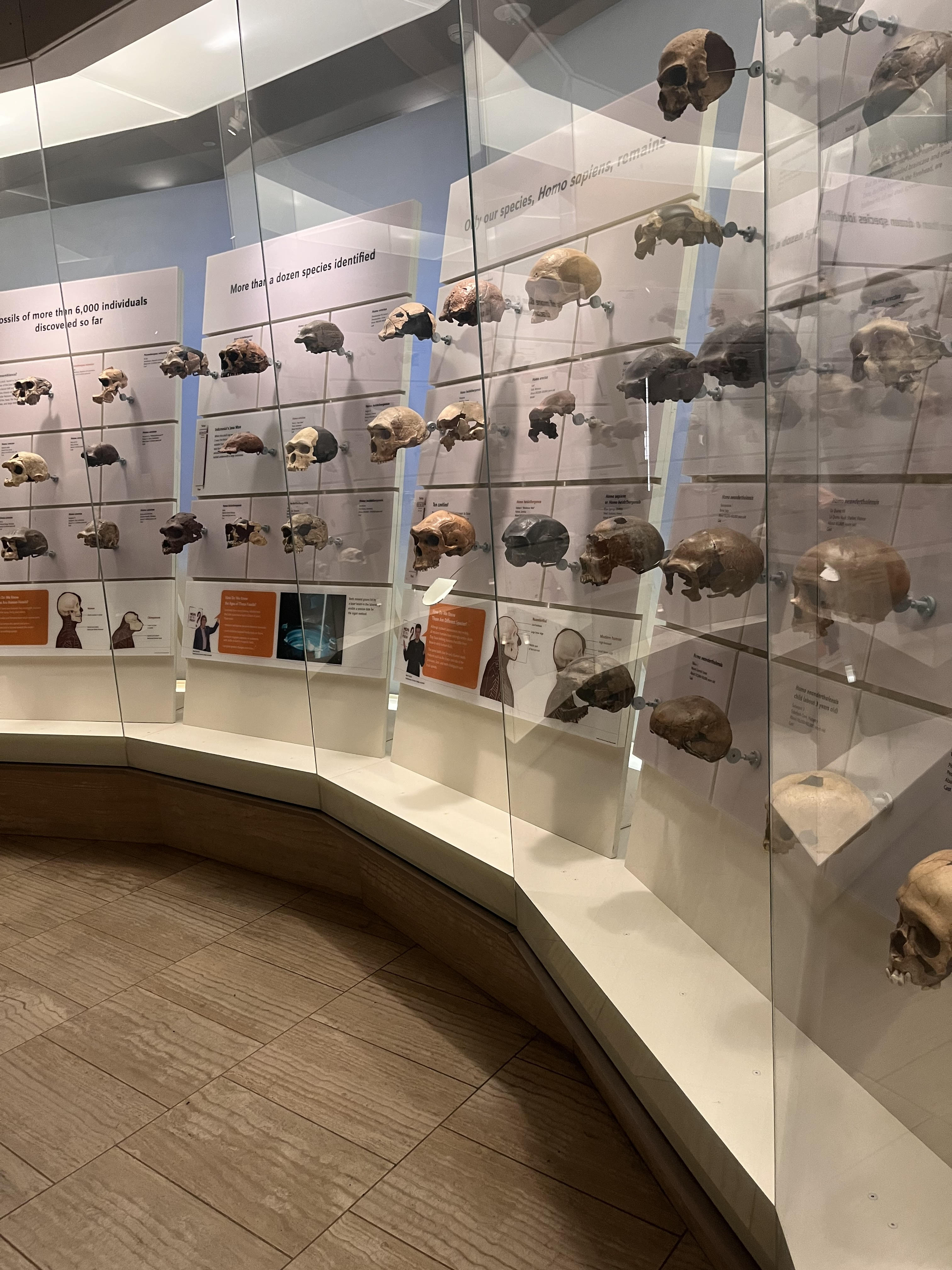
The next topic was about tool use in not only humans but also chimpanzees and other primates. Primates have used sticks as spears and ant dippers in the name of survival against competition and for food. They also have used stones to create tools, but not as complex as humans. For humans, there were actual tools on display in front of us showing the evolution of human tool making and how it started. It started off as simple stone flakes and stones that could be used to kill prey and create more tools, but soon evolved into spear heads, hammers, and pottery all on display.
Finally, the last topic spoken about was the climate and how humans have adapted to it and changed it. One thing shown was how vegetation has changed in the past and how humans have needed to adapt. It showed how pollen samples have been used to show how vegetation has changed due to seasonal changes and such. There were also displays showing how the climate has changed in accordance with the human time scale. But for the most part, it just showed how humans have impacted actual ecology and not the climate, which will be important in a bit.
When it came to the talk about climate change in the Origins of Humans Hall, I felt like the exhibit did in fact de-emphasize the severity and cause of climate change and just how humans have impacted the Earth. Firstly, they reused the same two images in the entire exhibit, being how oxygen isotopes have changed throughout history.
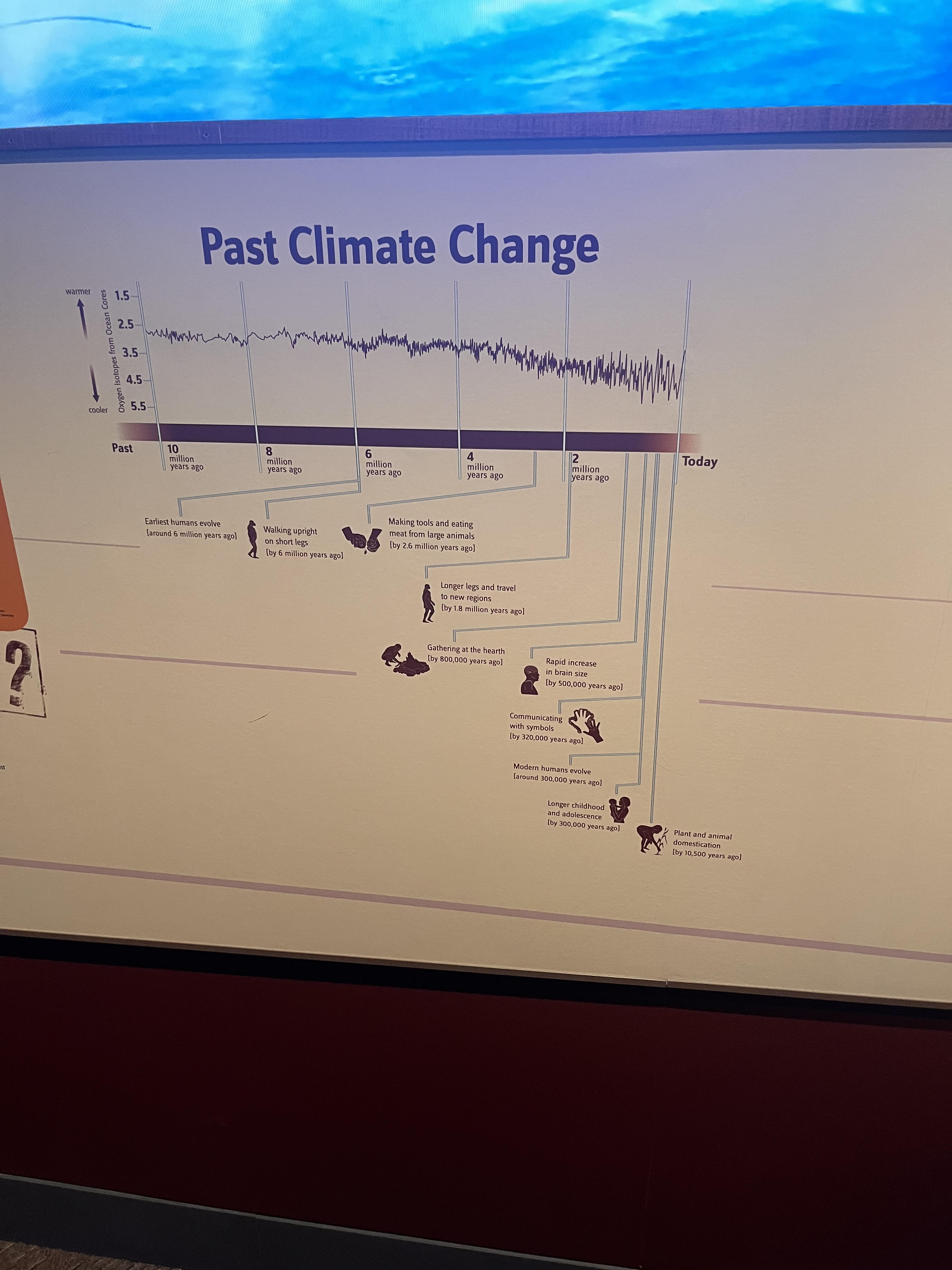
And this image was so out of proportion that the museum goers may not understand just how severe this graph is. Some might not even understand what oxygen isotopes are, since most are used to CO2 levels or temperature levels as measures of climate change. Plus this graph also uses different milestones below it to allow museum goers to have some relative events they can understand. But nowhere does it mention industrialization as a source of climate change, stopping at the agricultural revolution. Now there is a mention of CO2 levels in the past, but it feels almost excused and normal that CO2 is rising since it’s already happened in the past. And when it comes to mass extinction, there’s a portion that shows how humans have killed off many species throughout our history. But there’s no mention of how climate change has also been a factor in the deaths of these species. And just in the very layout of the exhibit,the climate change portion was very secluded from the rest of the hall, information that’s too small to catch people's eyes. So it feels like this portion of the exhibit does a bad job presenting how humans have impacted the climate throughout history.
Finally, I went to the Cellphones: Unseen Connections exhibit on the second floor, looking at the impacts of cellphones on society, technology, and the environment. Many of the ways that this exhibit presented information was through drawings, anecdotes, and physical objects. I feel like the physical objects were effective in giving an idea of what they were talking about, such as with e-waste. There was a drawer with phones and chargers that showed what an average person’s phone collection might look like. Plus there were antennas and servers on display that showed just how big these pieces of infrastructure are that run all our systems for phones.
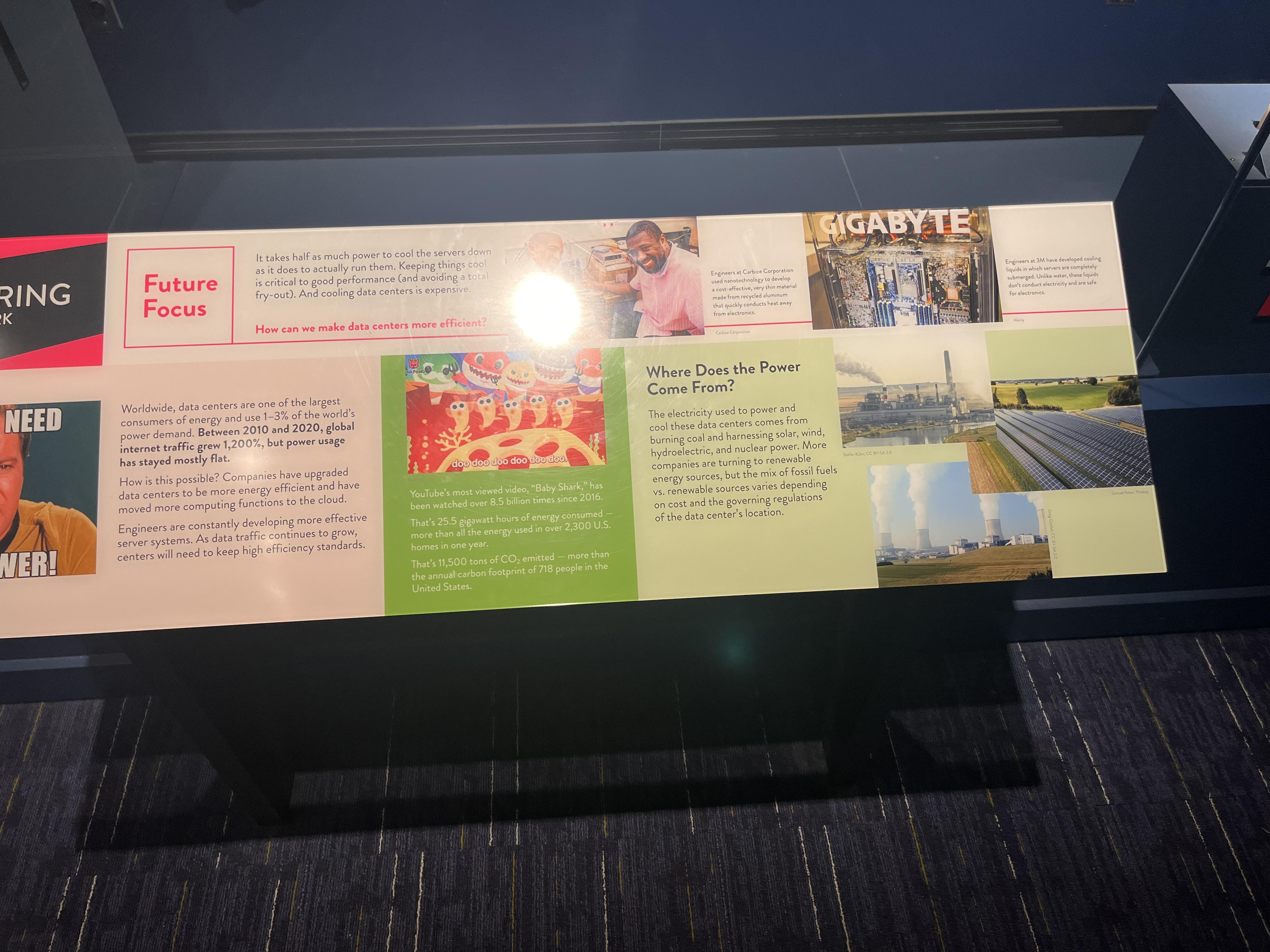
When it came to drawings, there were entire walls of comic-book-like storylines that displayed info from how phones have led to social change to the anxieties created. And finally, there were anecdotes that showed the experiences of people that mined, designed, programmed, and more when it comes to cell phones.
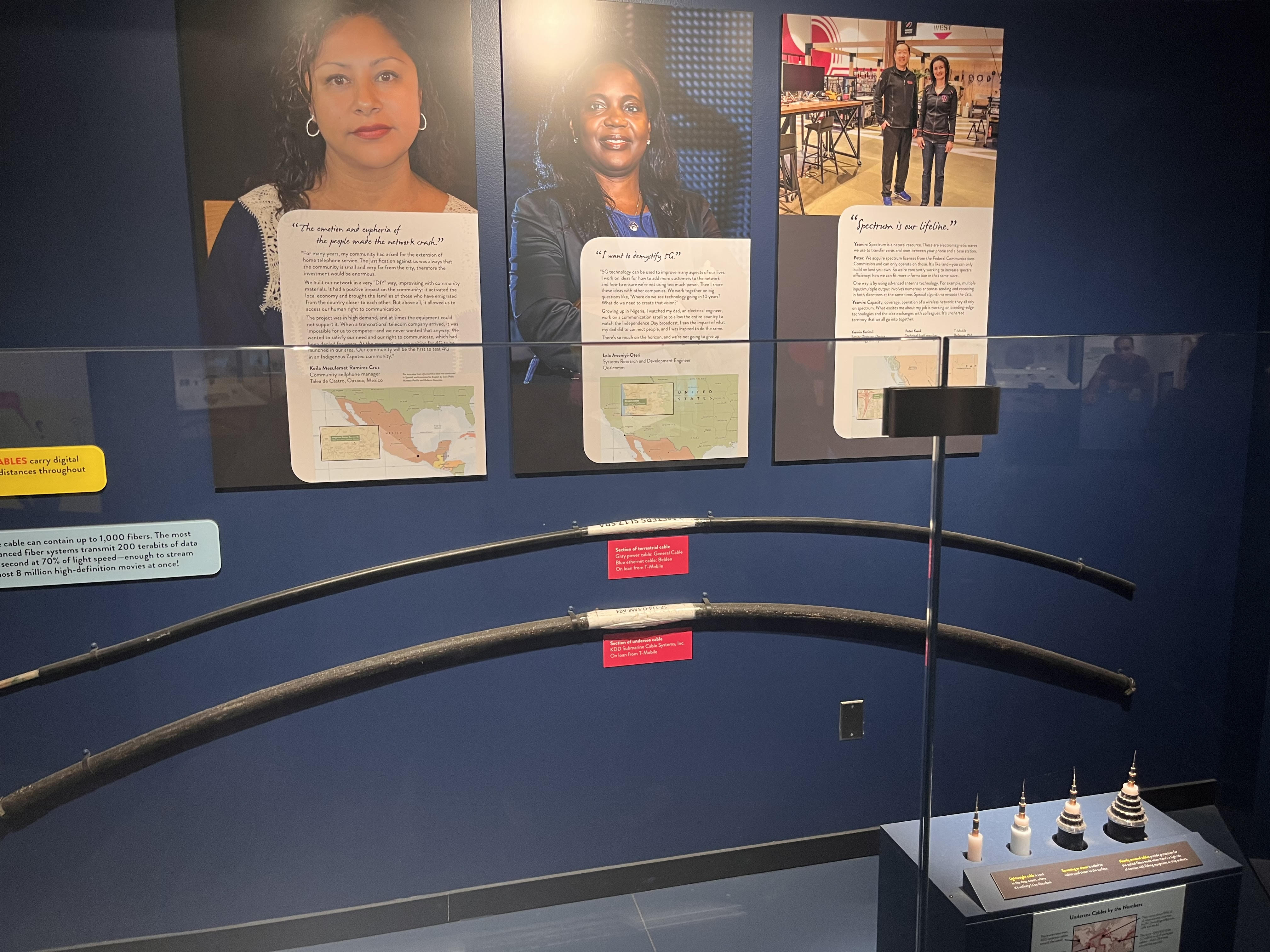
They were all pretty effective in conveying information, but also seemed very one-sided in making phones look less bad since the exhibit was funded by Qualcomm and T-Mobile. So it could’ve been flawed for sure, and some of the information was skewed to almost excuse the negative side of cellphones, from power usage to e-waste to mining. Throughout the start of the exhibit, the raw materials that go into phones are shown in cases, with the raw metals, circuitry, and elemental information being shown.

But when it comes to raw materials, the anecdotes shown say how good mining has been to rural communities, and how without it there would be no work. But there is no mention of the negative environmental impacts of extracting these raw materials. Later in the data centers portion, there is a small mention of just how much power these data centers use, 1-3% of the world power demand. But then it’s said that these data centers have supposedly become more energy efficient without a mention of how. It also mentions out of nowhere that Youtube views on baby Shark has generated 11,500 tons of CO2, not saying it’s negative or anything though. Finally when it comes to repairing, there is no blame put on phone manufacturers when it comes to e-waste. The consumerist culture created by these companies has led to constant upgrading of phones without a way to take back these phones, leading to further waste.
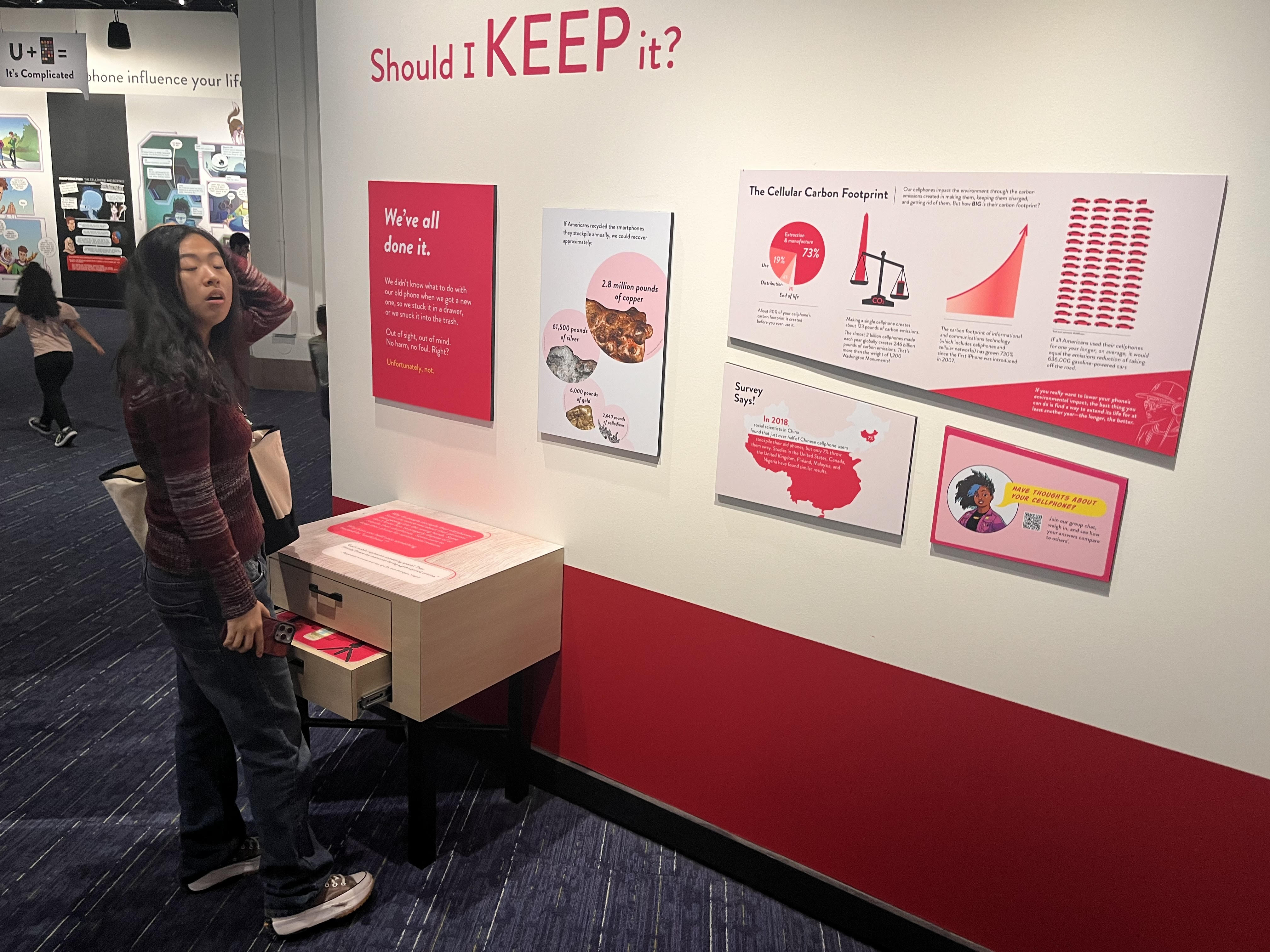
The exhibit basically says that the only way to reduce this waste is to extract resources from unused phones or to extend their lives, or else they just go to landfills. And all this information is shown through text, not in videos or physical displays, showing that they don’t want everyone to be able to see this text, instead being distracted by the many screens and games around the exhibit.
When it comes to the impacts of phones, there are many social and technological aspects represented throughout the display. One social impact is the social anxieties created from the introduction of such a new technology into the world. This was displayed through a little comic book of a cat that went through different centuries and showed how books, comic books,and films changed society in different ways. It said that phones are no different, and that they’re basically going to become the norm or are the norm.

Another societal impact was self-expression, which was displayed in both physical ways and in the same comic book style from before. Some of these ways of self-expression include connections to other people through We Chat, money transfers, and social justice movements like the Arab Spring and BLM.
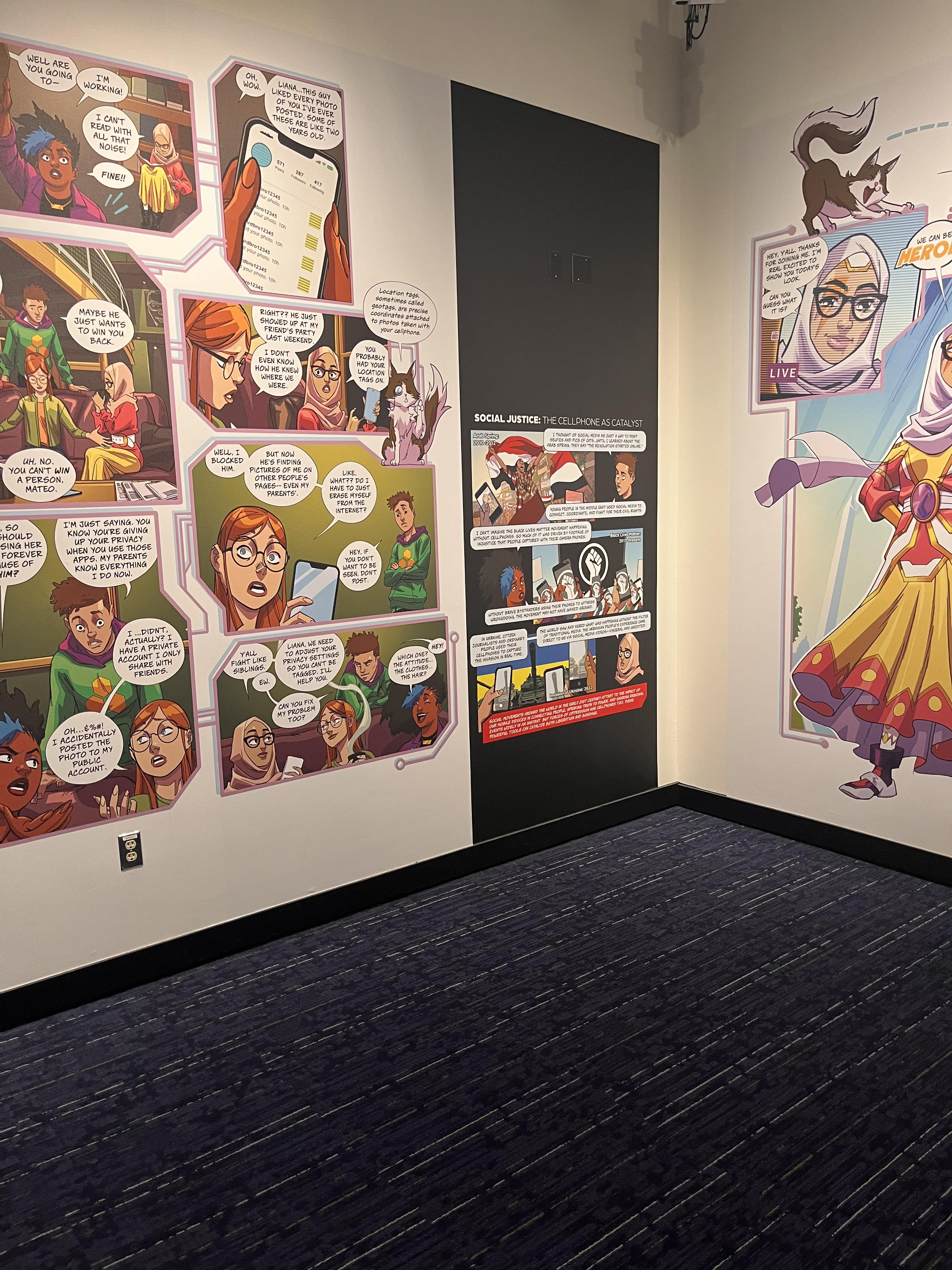
And one technological impact was improvements in circuit board and battery design due to the design constraints of cellphones. This was also shown through simple physical objects that visitors could see. All in all, cell phones have impacted much of society in many different ways.
Throughout the exhibits in the National Museum of Natural History, I saw just how climate change and societal change has been represented in so many different ways, but with so many similarities and connections. So it’s important to understand these complex webs and really understand just how these systems function, because it’s important to stay knowledgeable.



